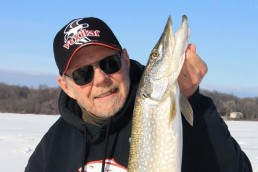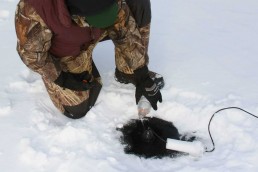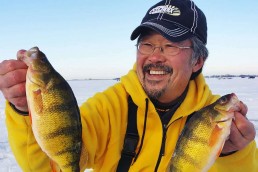Joy of Early Ice: Catching Panfish through the Ice
SHARE THIS POST
Just because the temperature outside is well below freezing, a foot of snow blankets the ground and 8 inches of ice tops the local ponds and lakes does not mean that there is not fishing to be done.
There is nothing quite like pulling a mess of panfish through the holes in the ice.
The first thing in ice fishing is safety: Do not venture onto the ice unless it is at least 4 to 6 inches thick. This is the minimum thickness that will safely support a person and equipment. Keep in mind that snow weakens the stability of the ice. Do not test just one area of the ice and assume that it will be the same depth at all areas of the lake or pond. It will not be.
Ice fishing accidents can quickly become deadly. Do not ice fish alone; always have someone with you and let people back at the house know where you will be and when you expect to return. That way, if you do not return on time, they know exactly where to look for you.
Frostbite and hypothermia are concerns for ice fishermen. You must be alert as to the amount of time you are on the ice and the weather conditions. Do not get overwhelmed with all the excitement and stay out too long.
Consider some sort of ice fishing shack to protect you from the elements if you plan to stay on the ice for long periods. There are plenty of commercially manufactured shelters on the market. Even a deer/turkey hunting blind will work.
There is nothing wrong with building a fire on the ice to stay warm. It will not weaken the ice or melt through as long as the ice was thick as it should have been when you began.
Ice fishing is not an expensive sport to get started in, and the gear is simple to use. An ice fishing rod and small mechanical reel will cost you less than $10. I highly recommend using ice fishing-friendly gear. Fish bites under the ice can be difficult to feel with “normal-sized” outfits. I suggest an ice fishing rig with 2-pound-test.
There are many options available for bait. For artificial bait, start with a small, flat-bodied jig. This bait “flutters” as it falls; this is good attractor bait. When fishing with jigs, your presentation must be very slow. It does not take much rod movement above the ice to make a jig have a lot of movement under the ice.
The first thing to do is lower your bait to the desired depth. If you are going to catch a big fish out of a hole, it will happen rather quickly. You have to be ready as your bait sinks on the first drop down a new hole.
Are you enjoying this post?
You can be among the first to get the latest info on where to go, what to use and how to use it!
If you do not catch a fish on the downward fall, let the bait sit for a minute, and then lightly jig it in a slow, smooth motion. Do your best to maintain a rhythm in your jigging. When you feel a bump, however small it might be, set the hook. Because you are using light line, be very careful not to break it.
When using live bait, I prefer mealworms and waxworms for bluegills, and minnows for crappies. Always use small in-line bobbers and watch for the slightest bite.
Fish don’t change if it’s cold—the best time for ice fishing is still going to be when the sun is low in the sky, or at night. The fish will still seek out the protection of cover and remain hidden in the shadows. And, they are still spooked by the same things, like the noise of you moving on the ice or the shadows of your movements.
It is still possible to catch fish during the midday with a few changes. The first thing you must do is to know where the fish will likely be hanging out: weeds, deep holes and deep water.
Fish will not be very active during the day, but will nibble at your bait if it falls in front of them. To catch fish with regularity you have to be willing to move, drill a lot of holes and keep at it until you find the fish. Do not believe that because you catch one fish out of a hole that you will catch another one right away. If you do not catch one in four or five minutes, move to a new spot.
Axes, chainsaws and ice augers are the three primary tools used to cut holes in the ice. Once the hole is chopped you will have to remove the slush and ice chips out of it. Commercially manufactured scoops for skimming the water are what I use. But any device that will keep your holes clear will work.
After ice has been covered with snow, the lack of sunlight will kill the vegetation. The lack of aquatic vegetation will cause the fish to move deeper. Crappies can be found mostly schooled around stumps or weedlines. You will find bluegills spread out around structure.
Besides midday fishing, another time when you might need to cut multiple holes is when a cold front moves in or the weather deteriorates. This will also likely cause the fish to move deeper. They will stay close to cover and might be hard to locate, so you need many holes. When you do find them, be ready for a good time.
Be sure you know the laws. Some bodies of water regulate the number of holes, number of rods and the number of fish you can keep.
MWO
SHARE THIS POST
Did you enjoy this post?
You can be among the first to get the latest info on where to go, what to use and how to use it!
Jason Houser
Jason Houser is an avid outdoorsman from Central Illinois. Houser has been a full-time freelance writer since 2008. He is also the host of Jason Houser Outdoors, airing on the Hunt Channel. He can be found on Facebook at Jason Houser Outdoors or on the web at jasonhouseroutdoors.com.



